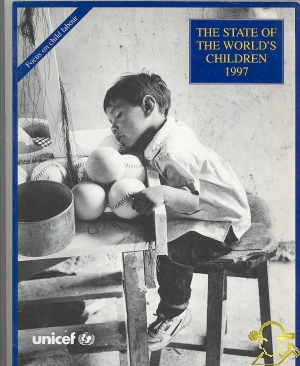 |
 |
 |
The State of the World's Children 1997
|
Book : The State of the World's Children 1997 Author : * -- Language : English Library : Child Labor Publish Place : New York ISBN : 0-19-262871-2 Publish Date : 00 2007 Publisher : UNİCEF Translator : -- Book Type : Book Book Number : 5767 |
 |
INDEX
Foreword by United Nations Secretary-General ....6Chapter I............7
The Convention on the Rights of the Child: A new era for children
The Convention on the Rights of the Child is at the core of a revolutionary shift in the world's approach to
children. The idea that children have special needs, which sparked the founding of UNICEF 50 years ago, has
now given way to the conviction that children have the same spectrum of rights as adults: civil and political,
social, cultural and economic. The Convention, nearing universal ratification, is setting in motion profound
changes in laws, policies, institutions and practices. UNICEF itself has adopted a mission statement that
looks to the Convention as its guiding force.
This chapter shows how the world's course towards peace, equality, development and justice can be hastened and helped by the energies the Convention is generating. The year 2000 goals, established at the World Summit for Children in 1990, must now be pursued in the context of the Convention. Progress towards those goals, according to a report in late 1996 by the UN Secretary-General, shows great strides made, with millions of children's lives saved since 1990. But much remains to be done. The Convention expands the scope of action now under way and calls for continuing commitments of both political will and resources.
Chapter II..............15
Children at risk: Ending hazardous and exploitative child labour
Over 250 million children around the world — in countries rich and poor — work and many of them are at
risk from hazardous and exploitative labour. Denied education and trapped in cycles of poverty, their most basic rights, their health and even their lives are in jeopardy. This chapter examines the issue of child labour in all its complexity, exposing the common myths about it and exploring the causes. The contributing factors are multiple and overlapping, including the exploitation of poverty, lack of access to education, and traditional restrictions, particularly for girls. Compounding the problem is the paucity of statistics about the number of children working, especially those in hazardous conditions. More data are urgently needed in order to better monitor and prevent child labour violations, particularly since the vast majority of children labour in invisibility.
Because the causes of child labour are complex, the solution must be comprehensive. The report calls for the immediate end to hazardous child labour and proposes strategies to help eliminate and prevent it including: access to education; wider legal protection; birth registration for all children; collection of information; and mobilization of the widest possible coalition of partners among governments, communities, non-governmental organizations (NGOs), employers and trade unions. The single most effective way to protect children from hazardous and exploitative labour, the report argues, is to extend and improve education so that it will attract them and inspire their lives.
Chapter III Statistical tables............77
Statistics provide an essential foundation for gauging children's well-being and the level of care, nurture and resources they receive. Statistics such as those on child mortality, immunization, maternal mortality, malnutrition and school enrolment chart countries' progress towards achieving the goals set at the 1990 World Summit for Children. Despite significant gains, more than 12 million children under five still die each year, mainly from preventable diseases and malnutrition. The tables cover basic indicators, health, nutrition, education, demographics, economic progress and the situation of women, plus indicators on less populous countries, rates of progress and regional summaries. Countries are listed in descending order of their estimated 1995 under-five mortality rates, the first basic indicator in table 1.
Panels
1 Children's Rights, Children's Voices...10
2 Bringing the Convention to Life..12
3 Legislative Landmarks..19
4 IPEC Partnershis for Children....22
5 Child Domestic Work: Hidden Exploitation..30
6 Kenyan Girls Find Hope at Sinaga ..34
7 Agricultural Labour: A Harsh Harvest..38
8 The Streets are Their Workplace..42
9 "How can I study?"..49
10 Non-formal Education: A Bridge for Working Children..50
11 Escuela Nueva: Alternative Learning for Rural Children...56
12 An Agreement in Bangladesh..60
13 The Private sector: Part of the Solution..64
14 Rugmark: Helping to Keep Children off the Looms..68
Text figures
Fig. 1 Child Labour: A Look at the Past..18
Fig. 2 The World's Children: How many, How Old?..24
Fig. 3 The Working Child: 1 Out of Every 4 in the World..25
Fig. 4 Long Days, Long Weeks ...25
Fig. 5 Family Purchasing Power Falls in Many Regions..27
Fig. 6 Purchasing Power: Industrialized vs. Developing Countries...27
Fig. 7 Children Out of School: A Cost and a Cause of Child Labour..52
References ....74
Index ....104
Glossary ....107


